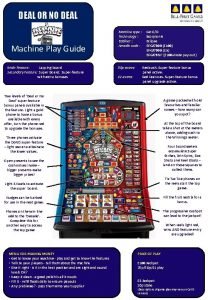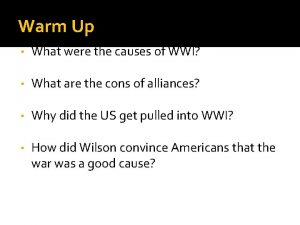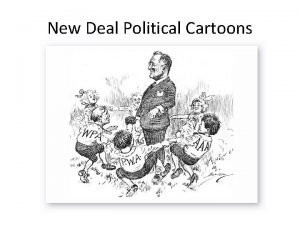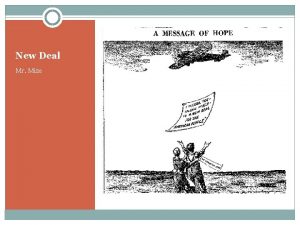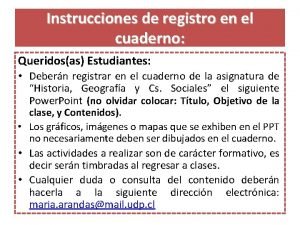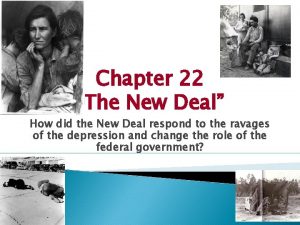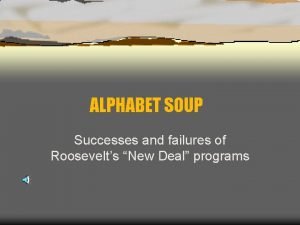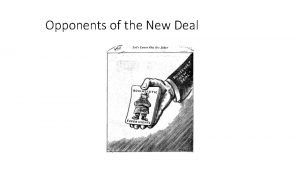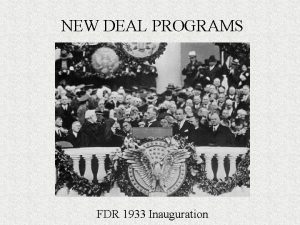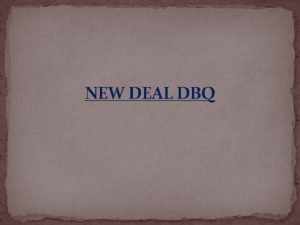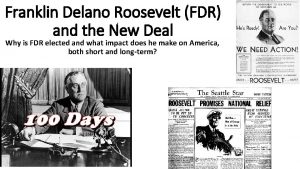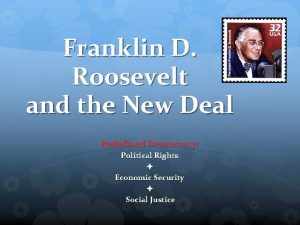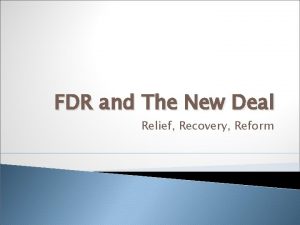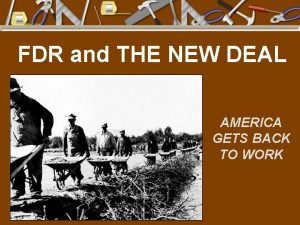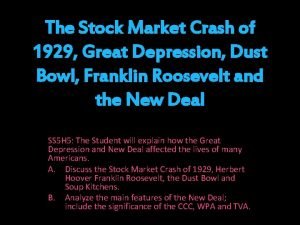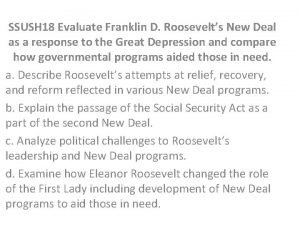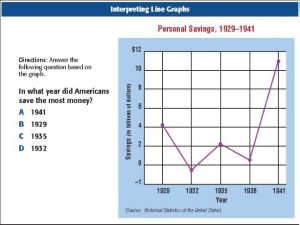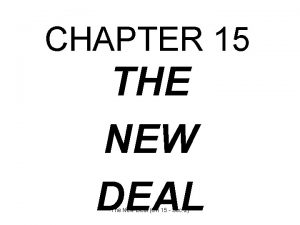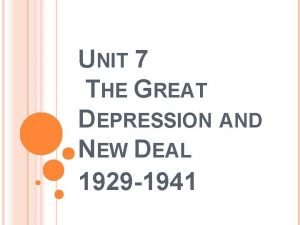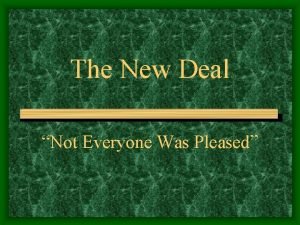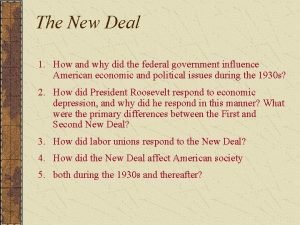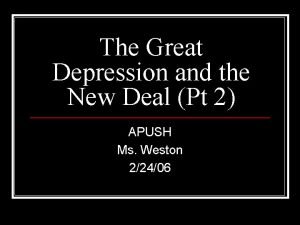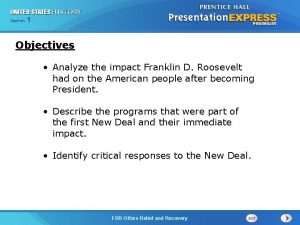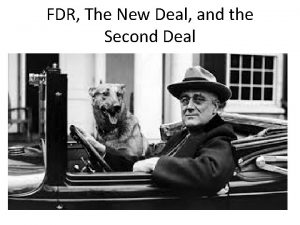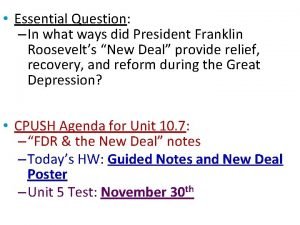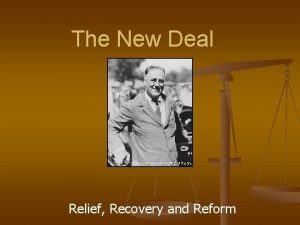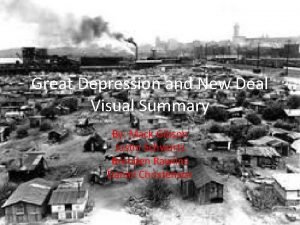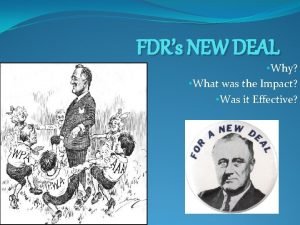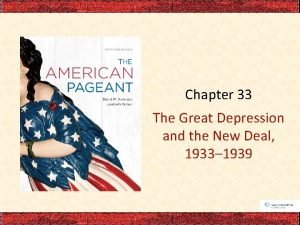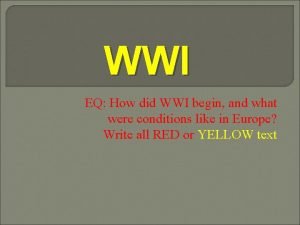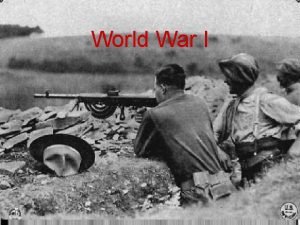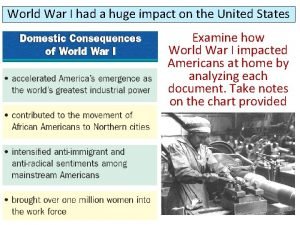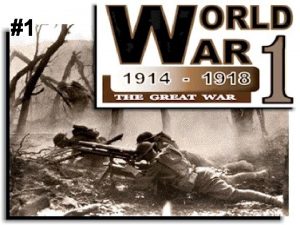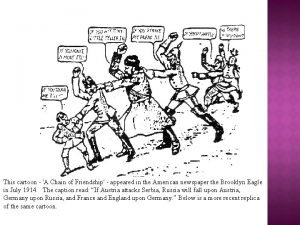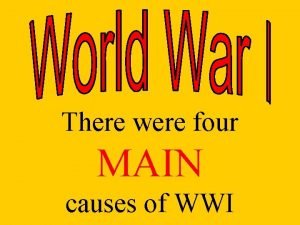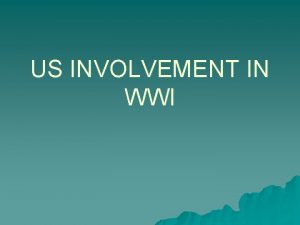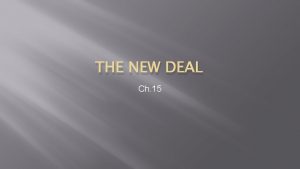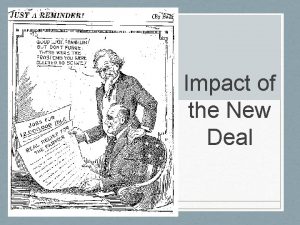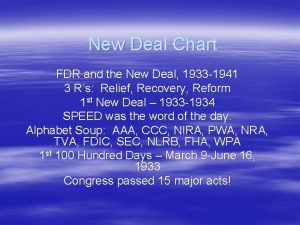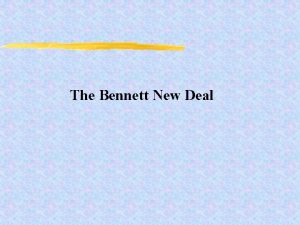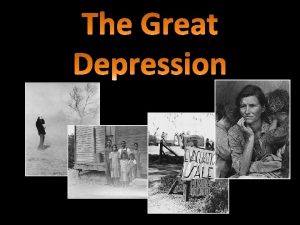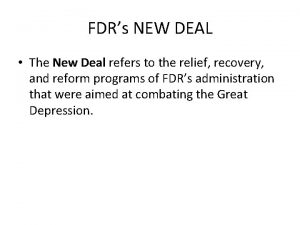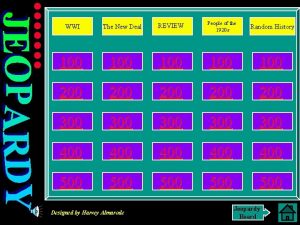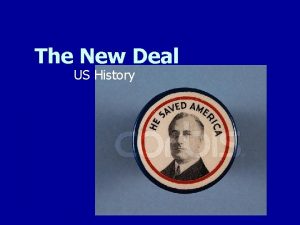WWI through the New Deal U S Involvement



























































- Slides: 59

WWI through the New Deal U. S. Involvement in WWI why we fought domestic impact preventing another war battling communism “Roaring 20’s” and Modern Culture Henry Ford Radio and Movies Harlem Renaissance Jazz age Great Depression Causes of Depression American life Dust Bowl Hoover Franklin Delano Roosevelt and The New Deal TVA Unions Social Security Eleanor Challenges

A Booming Economy: The 1920’s Income increases People purchase more goods “Boom Cycle” Companies expand hire more people Companies earn higher profits

Objective: To analyze the effect the car had on U. S. society. 1927 Ford Model T

· Henry Ford used assembly lines to produce cars.




Henry Ford & Mass Production

· The efficiency of the assembly line helped to decrease car prices. Ex. ) Model-T 1909 - $850 1916 - $360 1924 - $290

Effects of the Car Industry rubber steel oil The following industries grew as a result of the booming car industry: glass construction (roads and bridges) housing (as the suburbs grew) paint

* Employment and standards of living increased. * As World War I ended, technology focused on consumer goods. Ex) radios, washing machines, telephones, and cars * Increased wages caused an increase in buying power. How might this negatively impact society in the future? Huh? Well? Write it down already! 1925 RCA Radiola Super VIII





· In the 1920’s, the American car culture developed. - people easily traveled out of the cities into the country - suburbs grew as people moved from the cities Campers in Woodland Park, Seattle, WA; 19181920 As cars got less expensive and people had more free time, many people started to take car camping vacations.

Objective: To examine the causes of the Great Depression Do Now: How did an increase in wages help cause an economic boom?

Causes of the Great Depression II. Overproduction • Farms and factories overproduced beyond the demand. • Wages did not rise as fast as prices. • Therefore, people couldn’t afford to buy many goods. • Businesses suffered and laid off workers.

“Cycle of Disaster – Boom and Bust (pg 704)” – many businesses went bankrupt Businesses cut production Workers suffered from wage cuts and lay offs. Demand for goods fell. People had little or no money to spend.

The following slides demonstrate how buying stocks with borrowed money is a bad idea. We are going to need two student volunteers to read the parts. Don’t be shy.

Buying Stocks on Margin: Scenario A Hello, sir. I would like to purchase 100 shares of stock in the Ford Motor Company. How much is it going to cost me? investor stock broker

Buying Stocks on Margin: Scenario A Well, Ford stock costs $10 per share. You want to buy 100 shares? Figure it out yourself, smartguy! investor stock broker

Buying Stocks on Margin: Scenario A Ummm… 100 shares x $10 per share = $1, 000. 00 Oh, well. I only have $100. I can’t afford 100 shares. investor stock broker

Buying Stocks on Margin: Scenario A No, problem! Just give me $100 and you can owe me the rest! investor stock broker

Buying Stocks on Margin: Scenario A Like, how much would that be? Let me think… $1, 000 worth of stock - $100 paid = $900 owed investor Alright, it’s a deal!! stock broker

Buying Stocks on Margin: Scenario A Six months later, Ford stock doubles to $20 per share. My 100 shares are now worth. . . 100 shares x $20 per share $2, 000 investor stock broker

Buying Stocks on Margin: Scenario A That’s great! Now pay me the $900 you owe me! investor stock broker

Buying Stocks on Margin: Scenario A No problemo! It was a pleasure doing business with you! investor stock broker

Buying Stocks on Margin: Scenario A Now let’s figure out how much money I made! $2, 000 net worth - $900 owed $1, 100 profit - $100 initial investment $1, 000 net profit investor

Buying Stocks on Margin: Scenario B Six months later, Ford stock decreases to $1 per share. My 100 shares are now worth. . . 100 shares x $1 per share $100 investor stock broker

Buying Stocks on Margin: Scenario A Too bad, hotshot! You still owe me $900! investor stock broker

Buying Stocks on Margin: Scenario A But I’m broke! What am I going to do! investor stock broker

Buying Stocks on Margin: Scenario A I don’t care what you do as long as you pay me back! investor stock broker

As you can see, when you gamble (which is what buying stocks is) with other people's money you lose twice if the stocks go down. The stock market crash caused Americans who did not buy stocks to lose their entire savings when the banks loaned money for people to buy stocks with; who then lost it.

· Some people began to buy stocks on margin, which is similar to installment buying. * Unquestioned faith in the bull market helped lead to the Great Depression!

I. Stock Market Crash • On Tuesday, October 29, 1929, stock prices plummeted. • This became known as Black Tuesday.


III. Banking System • When the stock market crashed, people could not repay their loans to the bank. • Therefore, banks couldn’t give depositors their money and banks closed. • Many people lost their life savings.

Brother Can You Spare a Dime • http: //www. youtube. com/watch? v=4 F 4 y. T 0 KA Myo Listen to the song and make a list of things that you learned about the life of the singer before and after the Great Depression.

"Brother, Can You Spare a Dime, " lyrics by Yip Harburg, music by Jay Gorney (1931) They used to tell me I was building a dream, and so I followed the mob, When there was earth to plow, or guns to bear, I was always there right on the job. They used to tell me I was building a dream, with peace and glory ahead, Why should I be standing in line, just waiting for bread? Once I built a railroad, I made it run, made it race against time. Once I built a railroad; now it's done. Brother, can you spare a dime? Once I built a tower, up to the sun, brick, and rivet, and lime; Once I built a tower, now it's done. Brother, can you spare a dime? Once in khaki suits, gee we looked swell, Full of that Yankee Doodly Dum, Half a million boots went slogging through Hell, And I was the kid with the drum! Say, don't you remember, they called me Al; it was Al all the time. Why don't you remember, I'm your pal? Buddy, can you spare a dime? Once in khaki suits, gee we looked swell, Full of that Yankee Doodly Dum, Half a million boots went slogging through Hell, And I was the kid with the drum! Say, don't you remember, they called me Al; it was Al all the time. Say, don't you remember, I'm your pal? Buddy, can you spare a dime? DISCUSS YOUR FINDINGS!

Objective: To examine the Dust Bowl and the treatment of minorities during the Depression.

The Dust Bowl • During the 1930’s, the Great Plains suffered from deadly dust storms.

Causes of the Dust Bowl: • Overgrazing by cattle and plowing by farmers destroyed the grasses that once held down the soil.

• The loose soil, a drought, and high winds helped to cause the Dust Bowl. Dust Storms: "Kodak view of a dust storm Baca Co. , Colorado, Easter Sunday 1935

Dust Storms; "One of South Dakota's Black Blizzards, 1934"

Farmer and sons, dust storm, Cimarron County, Oklahoma, 1936. Photographer: Arthur Rothstein.

Melt White: Black Sunday - It's on a Sunday afternoon about six o'clock. And we was gittin' prepared to go to church and went to church in a team and wagon. And I'd gone out to kinda tend the chickens and stuff and back in the north it was just a little bank, oh, like about eight or ten feet high. We had one of those headers out on each end, you know. And I did a few things there around the chickens and everything and went back in the house and I said, "Dad, we ain't goin' to be able to go to church tonight. " And he said, "Why? " And that's how fast it's travelin'. And we was livin' in an old house that was 14 feet wide, 36 foot long, just one room, board and batten with a washed roof on it. It kept gittin' worse and wind blowin' harder and it kept gittin' darker and darker. And the old house was just a-vibratin' like it was gonna blow away. And I started

tryin' to see my hand. And I kept bringin' my hand up closer and closer and I finally touched the end of my nose and I still couldn't see my hand. That's how black it was. And we burned kerosene lamps and Dad lit an old kerosene lamp, set it on the kitchen table and it was just across the room from me, about -- about 14 feet. And I could just barely see that lamp flame across the room. That's how dark it was and it was six o'clock in the afternoon. It was the 14 th of April, 1935. The sun was still up, but it was totally black and that was blackest, worst dust storm, sand storm we had durin' the whole time. A lot of people died. A lot of children, especially, died of dust pneumonia. They'd take little kids and cover 'em with sheets and sprinkle water on the sheets to filter the dust out. But we had to haul water. We had a team and we had water barrels. We hauled stock water and household water both…

…And we didn't have the water to use for that, so we just had to suffer through it. And lots of mornin's we'd get up and strain our drinkin' water like people strain milk, through a cloth, to strain the debris out of it. But then, of course, a lotta grit went through and settled to the bottom of the bucket, but you had have drinkin' water. And when you got you a little dipper of water, you drink it. You didn't take a sip and throw it away, because it was a very precious thing to us because we had to haul it.

Effects of the Dust Bowl: • Farmers could barely make a living, causing many to leave their homes for the west. Farm foreclosure sale. (Circa 1933)

• Many farmers became migrant farmers as they moved from region to region looking for work. Farm Security Administration: Families on the road with all their possessions packed into their trucks, migrating and looking for work. (Circa 1935)

Farm Security Administration: farmers whose topsoil blew away joined the sod caravans of "Okies" on Route 66 to California. (Circa 1935)

Toward Los Angeles, California. 1937. (Dorothea Lange. ) Perhaps 2. 5 million people abandoned their homes in the South and the Great Plains during the Great Depression and went on the road.

• Migrant farmers from Arkansas became known as Arkies. Farm Security Administration: Arkansas squatter for three years near Bakefield, California. Photo by D. Lange. (Circa 1935)

• Migrant farmers from Oklahoma became known as Okies. Young Oklahoma mother; age 18, penniless, stranded in Imperial Valley, California.


Woody Guthrie – An American folk hero, he traveled with Dust Bowl migrant workers learning their folk songs and sharing their experience with the coutnry. Talkin Dust Bowl Blues Woody Guthrie - Talking Dustbowl Blues. mp 4

Hoover Takes Action • At first, President Hoover was against offering direct government relief. • Instead, he asked private charities, such as the YMCA, to help.

The Hoover Dam Hoover’s efforts to help Americans during the depression was too little to late. In the 1932 America looked to a new leader: Franklin Roosevelt.
 Deal or no deal machine
Deal or no deal machine Asset deal vs share deal
Asset deal vs share deal New technology in wwi
New technology in wwi New technology in wwi
New technology in wwi Great depression vocabulary
Great depression vocabulary New deal alphabet soup
New deal alphabet soup Chapter 15 section 3 the new deal affects many groups
Chapter 15 section 3 the new deal affects many groups Uneven distribution of income apush
Uneven distribution of income apush Aaa new deal
Aaa new deal New deal political cartoons
New deal political cartoons The new deal rrr
The new deal rrr Impacto de la gran depresion en chile
Impacto de la gran depresion en chile Emergency banking relief act (ebra)
Emergency banking relief act (ebra) The new deal an alphabet soup of agencies
The new deal an alphabet soup of agencies The second new deal takes hold chapter 15 section 2
The second new deal takes hold chapter 15 section 2 New deal alphabet soup
New deal alphabet soup New deal criticisms
New deal criticisms The new deal
The new deal New deal political cartoons and explanations
New deal political cartoons and explanations New deal critic dr francis townsend
New deal critic dr francis townsend The new deal webquest
The new deal webquest New deal programs
New deal programs William lloyd garrison jr new deal
William lloyd garrison jr new deal New deal
New deal The new deal redefined the role of the
The new deal redefined the role of the Forging a new deal section 1 answers
Forging a new deal section 1 answers Sec new deal relief recovery reform
Sec new deal relief recovery reform New deal fdr
New deal fdr The new deal
The new deal A new deal fights the depression
A new deal fights the depression New deal intézkedései
New deal intézkedései To introduce new just to deal
To introduce new just to deal Black sunday stock market crash
Black sunday stock market crash New deal program
New deal program Sec new deal
Sec new deal Tennessee valley basin
Tennessee valley basin What is the main idea of the cartoon?
What is the main idea of the cartoon? Great depression kinetic sculpture
Great depression kinetic sculpture New deal everyone
New deal everyone New deal
New deal New deal
New deal New deal
New deal A centerpiece of the second new deal was the
A centerpiece of the second new deal was the New deal
New deal Fha new deal relief recovery reform
Fha new deal relief recovery reform Actebra
Actebra New deal
New deal What was fdrs new deal
What was fdrs new deal Chapter 33 the great depression and the new deal
Chapter 33 the great depression and the new deal Chapter 15 section 1 a new deal fights the depression
Chapter 15 section 1 a new deal fights the depression Wwi webquest
Wwi webquest Where did wwi begin?
Where did wwi begin? Wwi sides
Wwi sides Main causes of ww1
Main causes of ww1 Impact of wwi
Impact of wwi Causes of nationalism
Causes of nationalism Chain of friendship political cartoon explanation
Chain of friendship political cartoon explanation Simulateries
Simulateries Imperialism 1900
Imperialism 1900 How many countries were involved in wwi
How many countries were involved in wwi
